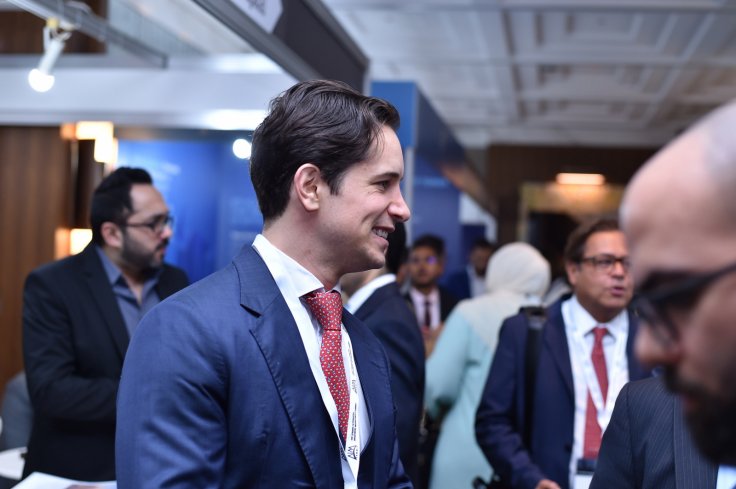
Alternative investment professional Zachary Cefaratti started in the world of finance at the age of 7, when he purchased his first bonds. He quickly moved into stocks as a teenager, and his love of all things financial has only grown in the subsequent decades. In addition to his work in investment banking and asset management, Cefaratti runs one of the most influential and renowned conferences in his industry, AIM Summit.
AIM Summit held its first edition in 2015, after Cefaratti found the other conferences he attended to be too commercialized and more focused on profits than on quality presentations. He set out to create a more perfect balance between value for attendees, value for sponsors, and value for the organizers. In doing so, he has elevated AIM Summit to a position of being arguably the most captivating and highest quality content conference in the world of finance.
Although AIM Summit got its start as the AIMA Middle East Hedge Fund Summit, under the brand of the Alternative Investment Management Association, the conference now covers many topics beyond hedge funds. Throughout their tenure, they have hosted more than 450 industry leaders as speakers, expanding from a half-day of discussions up to 2 full days of powerful presentations. Attendance is limited, and in an unusual move, Cefaratti reinvests all profits earned from AIM Summit back into the conference.
How Cefaratti Brings Value to Each Edition of AIM Summit
With 15 conferences in 8 years, it may be hard to believe that each edition has something new to offer. But thanks to Cefaratti's personal investment and commitment to AIM Summit, the conference continues to grow and attract thought leaders from all financial and economic sectors.
In order to stay up-to-date with all market trends and developments, giving his audience the best and most relevant content in the alternative investment industry, Cefaratti takes a multi-faceted approach. The first element is doing regular research, which happens to be a part of Cefaratti's daily routine as an investment professional.
"I actively monitor financial news, research publications, and industry reports to stay informed about current trends, developments, and emerging opportunities in alternative investments," he says. "I look closely at the authors of those reports and seek talent as potential speakers."
The next element is Cefaratti's constant networking and collaboration. "I maintain a strong network of industry professionals, including economists, fund managers, and thought leaders, with whom I regularly discuss market trends and insights. This collaboration enables the team to curate high-quality content for AIM Summit events."
Cefaratti also attends conferences and events that cover a variety of topics, both to learn new ideas and to observe best practices. He is perpetually engaging with thought leaders who can use the platform that AIM Summit offers to share insights and expertise.
The goal of AIM Summit is to provide attendees with an edge to better manage their investments in the ever-evolving alternative investment landscape. By prioritizing high-quality content production, including choosing the most relevant topics and the best industry experts, Cefaratti is able to set the bar very high.
Audience feedback makes up the last element of conference design and improvement. Continuously gathering feedback from attendees allows Cefaratti and his team to understand their needs, preferences, and expectations. They can then refine their offerings and adapt their programming to ensure that AIM Summit remains at the forefront of the alternative investment industry.
Measuring Success When Profits Aren't Part of the Equation
Although AIM Summit turned a profit in its second year, Cefaratti's reinvestment of all profits eliminates the easiest metric used to measure success. Instead, he uses several unorthodox, but more telling, markers to determine how AIM Summit is performing.
Among these is exclusivity: "By monitoring how many people were turned away or declined access, we can gauge the exclusivity of the conference," Cefaratti explains. "A higher number of declined attendees signifies that we've maintained a selective approach in curating our guest list, ensuring that only the most relevant and influential participants are in attendance."
The seniority of attendees within their companies and industries is also a factor that the organizers of AIM Summit keeps track of. "We track the seniority of our attendees, measuring the number of CEOs, CXOs, or owners present at the conference. A higher proportion of senior decision-makers in attendance reflects the conference's appeal to top-level executives, enhancing the networking opportunities and the potential for fruitful business collaborations."
Measuring the combined assets under management (AUM) of attendees also helps to assess the financial influence and potential deal-making capacity at each conference. A higher AUM means that AIM Summit has attracted significant market players, increasing the likelihood of partnerships and investments opportunities for all attendees.
"At AIM Summit, we also measure the ratio of asset allocators to asset managers in attendance," Zachary Cefaratti says of their last chosen metric. "Our goal is to maximize the proportion of allocators, such as family offices, UHNWIs, sovereign wealth funds, endowments, and pension funds. This is a crucial metric because a higher proportion of asset allocators ensures that there is a diverse and influential pool of capital sources present at the conference."
With a big-picture view of how AIM Summit can be much more than just ticket sale revenues, Zachary Cefaratti takes great pride in putting on an important event for his industry. His employees are able to attend his conference and enhance their knowledge of current events, and he himself gains access to industry professionals and partnerships that he otherwise wouldn't have.
AIM Summit's 15th edition will take place in Dubai October 30-31, 2023, and tickets are available now.









